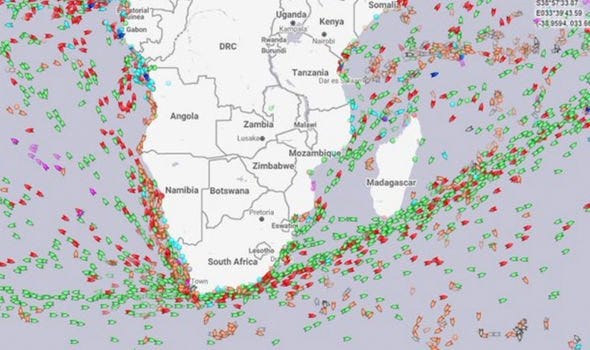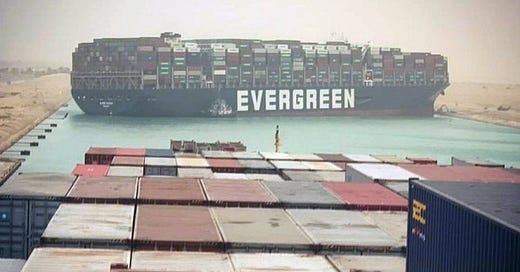Suez Canal Blocked Then Unblocked While Canada Legalizes Carbon Tax
The April Oil and Gas Issue 🛢️

The Suez Canal Gets Blocked and Then Unblocked
In the event you haven’t been on the internet in the last few weeks I am letting you know that the Suez Canal was blocked by a container ship called The Ever Given. The Suez Canal links the Mediterranean Sea to the Red Sea and enables ships to avoid going around Africa’s Cape of Good Hope. The Suez Canal is similar to the Panama Canal in that it is a vital shipping lane to the global economy and when vital pieces of economy stop working as in Texas last month we will begin to feel the effects. The good news is that The Ever Given got dislodged on Monday March 29th, but I think it’s worth going through the shock of the blockage.
A good place to start this story is with Stanley Reed who reported for the New York Times on how the blocked canal did not significantly influence oil prices and were actually already in a mild pullback from hitting a rolling year high in March. The fact that oil prices were declining during this whole debacle is a signal of the times we are in with Covid-19 and the lack of demand coming out of Europe. Typically, we would have seen prices spike on the fear that takes would have to go around the Cape of Good Hope. The oil price fall may have been driven in part by lack of vaccination roll outs and more restrictions due to Covid-19.
Reed further reported that there was fear that the bottleneck might persist when it happened and the bottleneck lasted days instead of the feared weeks. Even with days of delay some shipping companies decided to go around Africa anyway as opposed to waiting for the Suez Canal to open up. The Suez Canal allows about 100 ships per day to to pass through it and we get the great graphic below as a result.

Transport of finished goods from Asia to Europe and vice versa for CPG companies was mildly disrupted with this closure. Additionally, manufacturing which was already reeling from the Aftershocks of the Texas freeze got another dose of supply chain shock in Europe. Our markets are global and while Europe often exports luxury goods such as wine, cars, and Italian leather goods they also import raw materials to make a plethora of things aside from luxury goods. Electronics for the most part are made in Asia and shipped everywhere. Manufacturers that were waiting on raw materials will get their deliveries soon because the crisis is mostly over now. That is until the next one happens. We had to wait for a week for this to get resolved, which can often feel like longer because we are used to getting things now.
Leslie Scism and Benoit Faucon reported for the Wall Street Journal from the perspective of the insurance markets. Scism and Faucon wrote:
More than $3 billion of insurance is in place for liability claims against the owner of the grounded container ship Ever Given, officials with its insurance program said Friday.
It is unclear whether that will be enough to cover losses that are likely to be claimed by some of the more than 200 ships in the canal as of Friday, plus the owners of the cargo they are carrying, if the vessel continues to block the Suez Canal, industry executives said.
Cargo-delivery delays are where a lot of the economic damage would be expected if the critical waterway doesn’t soon open up again to traffic. Delayed shipments could result in manufacturers’ not receiving parts needed for assembly lines or retailers’ not getting spring merchandise in time to stock shelves. At the same time, shipowners who anticipated using their vessels for other cargo loads lose that opportunity as they sit in the canal.
I’ve never really considered the insurance aspect, but it totally makes sense after reading Scism and Faucon’s reporting. Marine insurance is the oldest form of insurance and was developed based on the fact that ships didn’t always make it to their destinations. The irony. Anyways, the Suez is back open for business and this is another example of the fragility of our globalized economy. Maybe supply chain insurance is going to get more expensive?
A Quick Detour To How Insurance Got Started
Tim Harford has a good story on the start of Lloyd’s insurance for the BBC. Edward Lloyd opened a coffee house back in 1687. Coffee houses were traditionally loud boisterous places where a lot of different socioeconomic classes interacted. Coffee shops were gathering places for merchants, traders, writers, politicos, and revolutionaries. These were the places where people gathered to talk about organizing, to exchange gossip, and to gamble on esoteric things.
Exporting and importing goods in the 1600s was a risky business and often merchants would place bets that their ships would not return to harbor and if the odds were good they could recoup a portion of their losses. Back in the 1600s a whole host of things could happen that could completely destroy a ship and the crew. Harford reveals some more irony because I am writing about all of this in a newsletter:
Edward Lloyd realised his customers were as thirsty for information to fuel their bets as they were for coffee, and began to assemble a network of informants and a newsletter full of information about foreign ports, tides, and the comings and goings of ships. His newsletter became known as Lloyd's List.
Lloyd's coffee house hosted ship auctions, and gatherings of sea captains who would share stories. If someone wished to insure a ship, that could be done too: a contract would be drawn up, and the insurer would sign his name underneath - hence the term "underwriter". It became hard to say quite where coffee-house gambling ended and formal insurance began.
Eight decades after Lloyd had established his coffee house, a group of underwriters who hung out there formed the Society of Lloyd's.
Seems like Lloyd’s was successful at this whole coffee house thing and my wife did just get us a free espresso maker on the internet 🤔. Insurance and newsletters are an old businesses. It will be interesting to see what the root causes for the Ever Given going sideways in the canal, but until then here is Sam Seaborne asking shipping executives to buy better ships as opposed to buying ships that need a lot of maintenance (if anyone has a better video clip let me know).
Meanwhile, Oil and Gas Rig Installations Are Up In the United States
The new highs in oil prices as well as strong vaccinations occurring in the US has prompted more oil and gas rigs to be going up in the United States. Scott DiSavino reported on the story for Reuters:
That puts the rig count, which has climbed over the past seven months, up 68% since falling to a record low of 244 in August 2020, according to Baker Hughes data going back to 1940. The total count, however, is still 361 rigs, or 47%, below this time last year.
U.S. oil rigs rose nine to 318 this week, their highest since May, while gas rigs were unchanged at 92.
If the Suez blockage had extended into weeks this would have been a great situation for the US oil and gas industry from an export standpoint. I think the bigger story around an oil price rally would be the prospects of the economy in the United States opening back up after a year or more of restrictions on travel, restaurants, and working in person.
As vaccinations restrictions lift in the US and more of the population receives the vaccine there should be increased demand for crude oil from refiners as people start commuting to work and people start traveling for leisure. Stephanie Soucheray reported for the Center for Infectious Disease Research and Policy for the University of Minnesota that many states are easing vaccine restrictions:
California is the largest state to announce a change in eligibility: On Apr 1 all residents 50 and older will be eligible, and all residents 16 and older will be able to get a vaccine on Apr 15. On Mar 29, Texas will open up its vaccination to all residents.
In a letter to the editor of The New England Journal of Medicine, Danuta M. Skowronski, M.D. and Gaston De Serres, M.D., Ph.D. made the argument for a single dose of the mRNA vaccine to be given out to more people to help stop community spread. They wrote:
We used documents submitted to the Food and Drug Administration1 to derive the vaccine efficacy beginning from 2 weeks after the first dose to before the second dose (Table 1). Even before the second dose, BNT162b2 was highly efficacious, with a vaccine efficacy of 92.6%, a finding similar to the first-dose efficacy of 92.1% reported for the mRNA-1273 vaccine (Moderna).2
I suspect we should get a short term increase in prices on oil in the next 4 months. Long term, I suspect the adoption of EVs and the concept of doing business deals virtually will temper oil prices from getting too high. I think we could see $75/barrel by July (previous prediction in February was by October) if the vaccine rollout continues its current pace.
Any sort of future taxation on carbon emissions could put a damper on additional investment into developing new oil wells and ultimately oil prices.
Canadian Carbon Tax Is Legal According to Supreme Court
I wrote last week about how our modern lives here in western society have externalized costs. One way to internalize those costs is to implement a carbon tax, which has been discussed by the World Bank and economists for years. A carbon tax has some general consensus on being an appropriate way to mitigate emissions. The real question is how much can you charge?
Canada’s carbon tax was implemented by Justin Trudeau in 2018 and essentially gives provinces in Canada a way to set their own pricing and if those provinces fail to meet certain minimum pricing requirements the central government can step in and set the price known as a “backstop.” The BBC has the outline of the policy and the pricing of the backstop is as follows:
Its current price sits at C$30 (£17.35) per tonne of carbon dioxide released and will rise sharply to C$170 (£98.38) per tonne by 2030.
The Trudeau government has expressed a desire to exceed its emissions reduction commitments under the Paris climate accords.
The Chief Justice for the Canadian Supreme Court wrote the majority opinion in a split decision allowing the tax, “Climate change is real. It is caused by greenhouse gas emissions resulting from human activities, and it poses a grave threat to humanity's future.”
I suspect that many Albertans would argue that their economy is dependent on oil and that much of Canada’s power stems from the fact that they are an exporter of energy. Biden canceling the Keystone XL pipeline was a blow to the Albertan economy, but everyone saw that coming once he won the election. Transitioning an economy that is completely dependent on oil to something else is a tricky thing to do and it will take decades to implement. There is no “silver bullet” technology that will save us here. Get ready for higher prices.
The Canadian carbon tax should not ultimately influence the majority of Canadians at C$30 per ton of carbon dioxide released directly. In the wake of Covid-19 the majority of people who can work from home probably should most of the time just from an emissions standpoint. Juliet Chen at Buffer had a great article on how our commutes are environmentally damaging:
Environmentally speaking, one of the biggest benefits of remote work is that you don’t need to commute to the office anymore.
The average American commutes to work by car just under one hour each day – roughly 32 miles, which equates to about 3.2 tonnes of CO2 per person every year.
The daily commute to and from work accounts for more than 98% of an employee’s work-related carbon footprint. Having the choice not to commute feels like a great way to cut our carbon footprint.
At C$30/tonne carbon if a Canadian has a similar commute to someone from the United States then they are looking at probably ~C$100/year in additional taxes, which is not a lot in the grand scheme of things. In 2030 things get pricier and C$500/year in additional taxes unless something significant happens such as being able to drive an electric car (see oil pricing prediction above).
My only issue with a carbon tax is that working class people who have to show up to work at a grocery store, an oil well, a factory, or a mechanic shop cannot work remotely and thus must pay the carbon tax. Their wages are also typically on the lower end of the spectrum and taxed at a higher rate compared to capital gains (at least in the US) so buying an electric vehicle is difficult. Then again if your job can be done 100% remote from your home then there is a strong possibility that it can also be done 100% remote in a country with a lower cost of labor.
The places where the carbon tax will really generate a lot of revenue for Canada is going to be in CO2 intensive industries such as cement, steel, and energy production. I suspect that these industries will pass the cost through the downstream supply chain and ultimately regular people will shoulder the additional costs on the goods and services that emit high amounts of carbon dioxide. This could lead to a rise in cement and steel prices, which could also lead to higher construction costs. This sort of carbon tax may also give some companies cover to spinoff their carbon dioxide heavy businesses at the behest of shareholder value.
Investors Still Focused on Environmental, Social and Corporate Governance or ESG for Sustainability
Rochelle Toplensky reported for The Wall Street Journal that there is still a rush for companies and assets that are in the green space. Toplensky reported:
The clamor on Wall Street for all things green has put spinoffs back on the agenda for energy producers. This time round, Europe’s utilities are likely to jettison dirty assets rather than clean ones.
Renewable-energy valuations have risen sharply in the past year, boosted by companies’ promises to reduce carbon emissions and governments’ increasingly ambitious transition plans. Money is flowing into ESG investing, which prioritizes environmental, social and governance criteria, leading to a so-called “greenium” for stocks that come with a green pitch.
A few months ago I wrote about how the New York City State Pension Fund divested itself of fossil fuel securities. Utilities and energy companies are essentially looking to divest themselves of “dirty” technology that got them to where they are and capitalize on this wave of new money by developing wind and solar energy generation assets. The issue that still has yet to be addressed is one of energy storage. The rhyme a collaborator of mine used to say was those who can’t store don’t have power past four.
Until a utility scale storage technology not dependent on lithium mining comes to market I think this rush towards green energy generation is a bit risky in the short term, but could pay off in the long term if you can pick a winner. I would look for who has a vision on how to solve the storage problem because if you get enough lithium mine closures then replacing those Tesla battery packs is going to be very expensive.
Toplensky wrote:
Assets in long-term decline, particularly those with an environmental stigma, will likely need to be pitched with well-developed strategies at low valuations to attract interest. Investors may stand the best chance of benefiting from the latest spinoff trend if they follow an old stock-market adage: Buy the rumor, sell the news.
I agree with Toplensky here at least in the short term of 6-12 months. I think long term carbon heavy goods and services will get taxed into oblivion or a viable substitute will be developed and take the place of the incumbent.
Talk to you next week,





The fragility in maritine shipping-dominated global supply chains has long been a big concern, for both economic and geopolitical reasons. Many are now foreseeing the possibility of a railroad based freight shipping network that connects the entire Europe and Asia, and most likely Africa too. It may take many decades to make this into reality, but the mere possibility of it alone shows that how rapidly the global power balance is shifting.
"My only issue with a carbon tax is that working class people who have to show up to work at a grocery store, an oil well, a factory, or a mechanic shop cannot work remotely and thus must pay the carbon tax."
Right. Which is why a carbon dividend is probably a necessary component of an effective system. http://www.intergalacticmedicineshow.com/cgi-bin/mag.cgi?do=columns&vol=randall_hayes&article=016